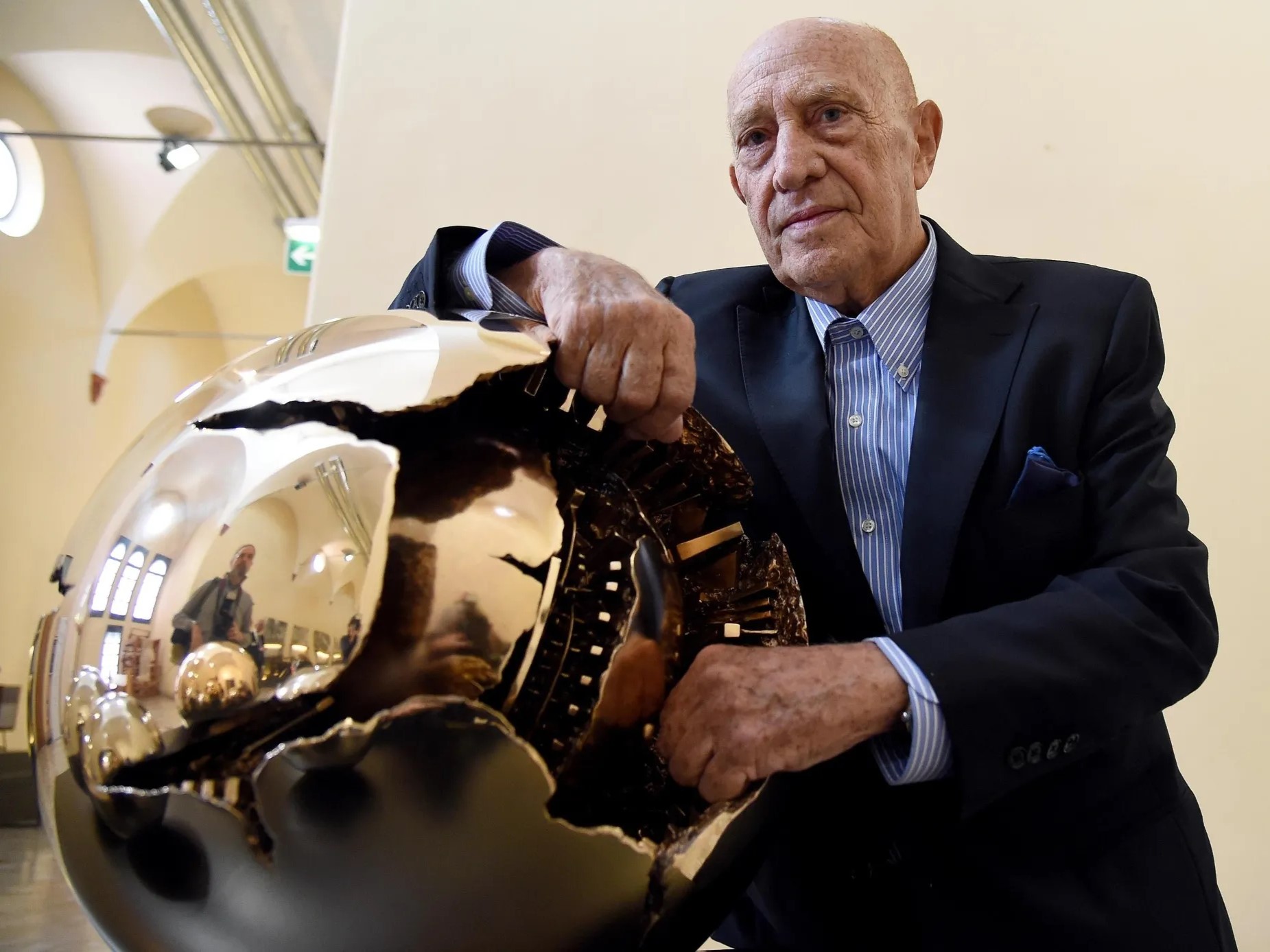
 Alberto Improda
Alberto Improda
Italian design: Arnaldo Pomodoro, between art, design, and architecture
- WTI Magazine #189 Jul 12, 2025
-

 Alberto Improda
Alberto Improda
On June 22, 2025, on the eve of his 99th birthday, Arnaldo Pomodoro passed away in Milan. The renowned sculptor, originally from Romagna, stood out as a figure of profound depth and distinctive originality in both the Italian and international contemporary cultural scenes.
Pomodoro’s work resists easy classification within any specific artistic movement. Instead, it occupies a unique and ideal intersection between art, design, and architecture. From the early 1950s, he developed a highly personal and distinctive visual language, grounded in the exploration of materials and their expressive potential.
His first works were high reliefs made from a range of materials—from gold and silver for jewelry, to iron, wood, and cement. He later chose bronze as his preferred medium, appreciating its flexibility and solidity, suitable for both small-scale pieces and large, monumental works.
From the outset, his art revealed a kind of unprecedented sculptural writing—a network of marks, etchings, scratches, and symbolic geometries that transformed surfaces into dynamic fields, into maps that incorporated the dimensions of Space and Time.
Starting in the early 1960s, Pomodoro moved away from the two-dimensional plane to fully embrace three-dimensional space, treating sculpture as a body within its environment. His works took on archetypal forms—spheres, discs, pyramids, columns, and cones—riven with gashes, slashes, and deep fissures.
In 1966, Pomodoro was commissioned to create a monumental sphere, three and a half meters in diameter, for the Expo in Montreal. This marked a pivotal moment in both his personal and artistic journey. Today, that work stands permanently in front of the Farnesina—the Italian Ministry of Foreign Affairs—in Rome. It signaled his entrance into the world of international public art and became the prototype for a long series of installations in public and institutional spaces across the globe.
Pomodoro’s sculptures found prominent homes in public squares and civic spaces around the world. The most famous are the spheres outside the Ministry of Foreign Affairs in Rome and the United Nations Headquarters in New York. Others are located in Milan, Copenhagen, Brisbane, Paris, Los Angeles, and beyond. His works naturally and effectively integrate into their urban environments, establishing a reciprocal and organic relationship with their surroundings—achieving a real sense of integration and interaction.
In Pomodoro’s own words: “A sculpture only has meaning when it transforms the place where it stands—when it bears witness to its time, when it manages to imprint itself on a setting and enrich it with further layers of memory.”
The relationship between Arnaldo Pomodoro and the United States was essential to his career.
He taught at both Stanford and Berkeley, maintaining an ongoing dialogue with American cultural figures and institutions for decades. In a 2023 interview with Fiorella Minervino for La Repubblica, he reflected: “America, where I first traveled in 1959, was crucial for the development of my work. On one hand, it offered a completely different sense of space. On the other, it gave me direct contact with the artistic and cultural movements of the time—a climate of non-academic, non-rhetorical openness to art, with strong attention to innovation and new expressive languages.”
Pomodoro’s unique position at the crossroads of art, design, and architecture also surfaces in a curious anecdote told by Giorgio Soavi in his book Adriano Olivetti – An Italian Surprise. The Lombard poet and novelist, a longtime collaborator of the engineer from Ivrea, recounted that at one point Adriano Olivetti asked him: “Who would you choose to design the casing for the first Italian electronic computer from Olivetti?” “I had no doubt,” Soavi said. “I immediately thought of Sottsass.” Sottsass worked tirelessly with designer Mario Tchou on the machine—“a collection of boxes and cabinets containing wonders I would never fully understand.”
When the cabinet was ready, it was announced that President Giovanni Gronchi would visit the Olivetti building on Via Clerici in Milan—designed by Fiocchi, Bernasconi, and Nizzoli (and later sold by Carlo De Benedetti once he took over the company).
Olivetti asked Soavi what might serve as an appropriate gift for the President.
He selected a small sculpture by Arnaldo Pomodoro, then a little-known young artist, who created a bronze object titled The Mathematician’s Stones.
Pomodoro’s name was splashed across every major Italian newspaper.
From that moment, Italy had its first computer, Pomodoro became a known figure, and Olivetti was officially among the world’s great innovators.
As Sebastiano Bagnara once wrote, “Design can be seen as that human activity which systematically distributes knowledge into the environment—where and when it will be needed—liberating us from the burden of having to remember it.”
Arnaldo Pomodoro left behind works that will serve as critical landmarks for the archaeologists of the future—true maps of the wounds, aspirations, and anxieties of our time.